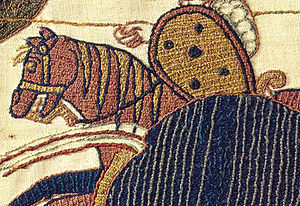Part 2: Two Parables
Before we discuss Karl Ludwig Schmidt’s views on the genre of the canonical gospels, I want to present two parables that I hope will drive home some basic concepts. A review of the recent scholarship on the subject reveals a distressing amount of misunderstanding here. I hope the following illustrations will help clarify two of Schmidt’s fundamental ideas.
The Platypus
Imagine for the moment that Richard Burridge has a younger brother, Bucky Burridge, who is an up-and-coming zoologist. One day while visiting an Australian museum of natural history, he comes face to face with a stuffed and mounted platypus. He has never seen a platypus before, and he is struck by its features. In many ways, it is like nothing he has ever seen, but after careful consideration, he believes he knows the proper classification of this so-called “mammal.”

Bucky hunts down the curator of the museum and asks for a few minutes of his time. “Did you know,” he asks the curator, “that you have classified a duck as a mammal?” The curator is confused, so Bucky drags him back to the exhibit of the platypus.
He points at the display case, tapping the glass. “The placard identifies this duck as a mammal!” says Bucky with a frown.
The curator pauses to make sure Bucky is serious, then tactfully asks, “Why do you think it’s a duck?”
“Well, it’s true,” says Bucky, “that it is a rather unusual looking duck. However, I am a zoologist, and I can assure you there are clear markers. First, we can see the obvious physical features: the bill and the webbed feet.”
The curator clears his throat. “Ah, yes. But . . . how do you account for the four legs and the fur?”
“Good point, but irrelevant. At first those features nearly had me convinced that it’s a mammal. But then I noticed from the description on the placard that the female lays eggs! And we all know that mammals are warm-blooded, furry creatures who bear live young.”
“Actually, if I may interrupt,” says the curator, “that isn’t quite correct. Mammals may or may not bear live young. What clearly distinguishes the platypus as a mammal is the fact that the female secretes milk. Mammals have mammary glands. More than that, the DNA evidence is indisputable. They belong to an order of mammalia called monotremes — mammals that lay eggs.
“Furthermore, you should know that by definition, all birds have feathers, wings, and two feet. So even if you weren’t sure about the mammalian classification, it cannot be a bird.
“Are you sure you’re a zoologist?!”
Where did Bucky go wrong? First, he mistook superficial features as identifying features. Second, he ignored important contradictory attributes. Of course, he also hadn’t done his homework on the mammalian family tree. And if he’d been up on his reading, he would have known about the DNA evidence.
Here are the lessons we should learn from the parable:
- We must learn to distinguish between extraneous features and identifying features.
- Contradictory features and missing features are just as important as other seemingly important observed features. Beware of confirmation bias.
- Knowing where something came from is crucial for understanding what it is and for being able to place it within a given classification scheme. Even if it appears to possess one or more defining characteristics of a species, its genome may tell a different tale.
The Commemorative Quilt
Let’s suppose that Richard Burridge has a younger sister, Becky, who is an art historian. While visiting a small town in the American Midwest she happens upon a local museum. She finds, to her delight, a superb example of a commemorative quilt.
Following the panels from left to right, the quilt tells the story of the town: the settlers arriving from the old country, tilling the soil, building the local pottery, raising their families, selling their grain, feeding their cattle. Becky has never seen anything like it.

She asks the pleasant older lady at the information desk, “To whom may I speak concerning the tapestry hanging in the main hall?”
“You mean the quilt?” asks the lady.
“No, it’s a tapestry,” Becky insists. “I would love to meet the artist.”
“Well, a lot of the women who stitched it together back in ’52 are dead. However, I’m pretty sure Mrs. Svenson is still alive. She’s moved away now, though — lives with her daughter out in California.”
Becky shakes her head. “You don’t understand. A work that beautiful, that powerful — it has to be the work of an inspired artist. The tapestry bears the strong sense of intent; the hand of the artist is evident in every stitch.”
“I don’t know what to tell you, ma’am. The town got together and decided to create a commemorative quilt for the town’s centennial celebration. There were about 30 or so ladies who worked on different parts of the quilt. The older women, they sorta ran the show. Each of the panels tells a story, how our grandparents and great-grandparents remembered it, anyway. And one lady was in charge of each panel. She was given a lot of leeway, so that’s why the panels all look different. It’s a fine example of American folk art.”
Becky says, “I sorry, but I’m an art historian. This tapestry is more than folk art.”
The nice lady continues, “You keep calling it a tapestry. But it’s a quilt.”
“I happen to know that a tapestry is a hanging piece of textile art,” Becky explains. “So while you may think of it as ‘just a quilt,’ it is in fact a piece of high art. I don’t suppose you’ve heard of the Bayeux Tapestry, have you?”

“Ma’am, it may surprise you to know that I’ve visited Reading, and I’ve seen the replica. Our quilt has some things in common with the Bayeux Tapestry — it’s an object made of fabric that hangs on a wall; it’s a piece of art that we’re proud of; it tells a story. But what you seem to forget is that a tapestry is woven. The Bayeux Tapestry was embroidered. So technically, it isn’t actually a tapestry. On the other hand, a quilt is stitched together from swatches of fabric. It is certainly not a tapestry.
“And besides that,” she adds, raising her voice slightly, “there’s no shame in calling it folk art. I don’t suppose you have heard of the Quaker Tapestry, have you? It’s also a large, hanging collection of embroidered panels, but it’s the work of a community.
“Are you sure you’re an art historian?!”
Where did Becky go wrong? First, like her brother, she was not aware of the crucial identifying features of a tapestry or, for that matter, a quilt. Second, and more importantly, she had convinced herself that she was looking at a piece of “high art,” which drove her to the erroneous conclusion that there was a level of intentionality, control, and artistic focus that was in fact absent.
Further, she mistakenly thought of “folk art” as inferior to “high art.” Finally, she did not fully understand that the quilt, which was the product of a community, could not be compared to a piece of so-called “fine art.” She was trying to compare apples to oranges.
What can we learn from this parable?
- Once again, we need to be aware of identifying features versus extraneous features.
- Works of art (or literature) created by a group or “folk” — i.e., folk art (or community-generated narratives such as the gospels) — are categorically different from works of high art (or literature) that are created by individuals. The terms high and low art (or high and low literature) do not represent judgments as to their beauty or worth. They are simply terms of art.
- As we stated above, knowing where something came from and how it came into existence is crucial for understanding what it is and for being able to place it within a given classification scheme.
What do the parables have to do with Schmidt?
As we will see in greater detail in the next installment, Schmidt criticized those who compared the gospels to ancient biographies on several grounds. He notes, for example, that Clyde Weber Votaw (see “The Gospels and Contemporary Biographies” at JSTOR) focused on several extraneous features that seemed to indicate that the gospels fit in the category of Greco-Roman biography while ignoring important, defining characteristics that are missing.
Schmidt also painstakingly demonstrated that the gospels are products of a community and belong to the realm of Kleinliteratur (“small” or folk literature), not Hochliteratur (“high” literature). The resulting product and its various attributes are constrained by the community that created and remembered the constituent pieces — viz., the pericopae that comprise the gospels — as well as the overall theological concerns of the community.
You can agree or disagree with Schmidt’s conclusions. However, what has happened over the past couple of decades is that scholars have so misunderstood Schmidt that they’re fighting a cartoon caricature of the great form critic. In some cases, they’ve conflated Bultmann’s views with Schmidt’s. In others, they simply don’t seem to have a clue as to what Schmidt was driving at.
If he were living today, Karl Ludwig Schmidt might ask, “Are you sure you’re a New Testament scholar?”
Next time: Schmidt on The Place of the Gospels in the General History of Literature.
[Note: I fixed several typographical errors at about 3:00 AM Vridar Standard Time. –taw]
Next Post — Part 3: K. L. Schmidt: Placing the Gospels
If you enjoyed this post, please consider donating to Vridar. Thanks!

I know you’ll roll your eyes at a comment about the platypus rather than Schmidt, but I do find John Gould’s platypuses somewhat unnatural. I can forgive him, of course, since if you are lucky enough to ever see them in the wild they will never expose themselves long enough for anyone to make a sketch.
They look like beavers dressed up for Halloween, don’t they?
Amazing.
I just had a conversation trying to explain to a fellow academic in the hard sciences why Burridge’s work is in my opinion rife with confirmation bias.
I gave an example of trying to prove that a lizard is a mammal by finding ten other mammals and pointing out all the similarities (four legs, two eyes, tail, etc.).
I mean come on, at the very least pick ten random texts and see which is in fact most similar, not the ten texts that seem sufficient to prove your prejudice.
Well said, Tim! I’ll be sure to cite you in my own work.
Also, you seem to be bang-on about the widespread misunderstanding of form criticism and the form critics. The neglect and caricature of their central insights has been all for the worse for biblical studies.